Monday, 26 May 2014: Narbonne, from prehistory to antiquity
Written 29 May
This was our last shot at museums in Narbonne, because on Tuesday, our last day there, they would all be closed (all over France, I think it's national museums closed on Mondays and local and regional closed on Tuesdays, or maybe it's the other way around), so we set off promptly for the bishop's palace to visit the museum of archeology, also covered by our combined ticket and billed as covering prehistory through antiquity. A huge group of middle-school children had been bussed in from Carcassone (where all the history is medieval) to tour the educational sites of Narbonne, and a group of 20-30 of them, accompanied by two teachers and a certified lecturer from the mayor's office, trooped through the museum every half hour or so. David loves to trail those school-group tours because the guide speaks loudly and distinctly, uses a slightly simplified vocabulary, and explains things more fully. In the course of the morning, he followed four such groups—each time one would exit at the end of the tour, he would walk back and pick up the next at whatever stage they had reached. Interestingly, the different guides chose different items to stop and emphasize, so it wasn't that repetitive. For example, in the same room, one guide talked at length about the fullers' and dyers' trades, which used urine in the processing of woolens (holding the kids' attention by means of the yuk factor), whereas the next chose to explain why Narbonne is full of images of bulls, which represented Cybèle, goddess of fertility, and described the ritual through which a childless woman attempted to jumpstart her own fertility—she lay under a metal grid, on which a bull was sacrificed, so that the blood from its slit throat would wash over her—a different rivetting yuk factor.
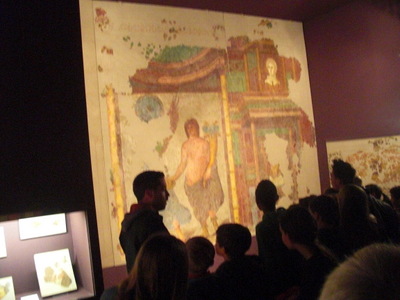
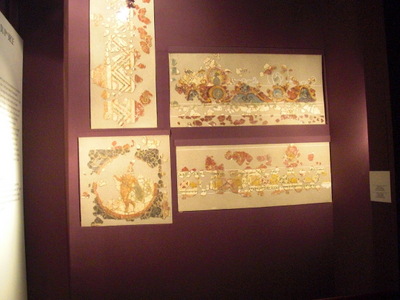 I, on the other hand, checked in with the groups from time to time but mainly came and went, reading the explanatory materials and spending a good deal of time in the one large room (halfway through the tour) devoted to prehistory, which the school groups skipped, sticking to Greek and Roman antiquity.
I, on the other hand, checked in with the groups from time to time but mainly came and went, reading the explanatory materials and spending a good deal of time in the one large room (halfway through the tour) devoted to prehistory, which the school groups skipped, sticking to Greek and Roman antiquity.
Near the beginning of the tour were these frescos, recovered from "La Maison des Portiques" (the house of the porticos), a site near the center of Narbonne that's still under excavation. The plaster bearing them had fallen off the walls, and archeologists have had to piece them together like puzzles to reconstruct even the fragmentary portions on display. These would have been wall decorations, either in the atrium (La Maison des Portiques is Roman in design) of in the various rooms.
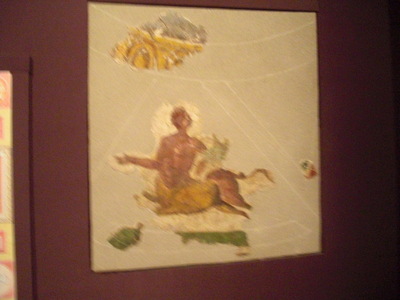
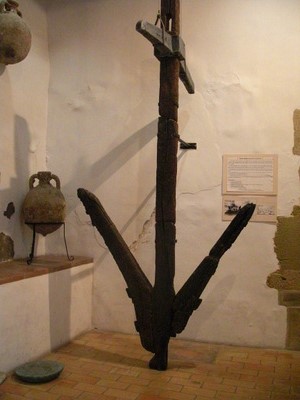 After the frescos come several rooms of three-dimensional artifacts, including the ubiquitous amphorae of all sizes (you can see some to the left of the giant anchor. Amphorae were the beer cans and plastic drink bottles of antiquity, but couldn't be recycled. They were used to ship and store everything from wine and olive oil to grain and coins and were so cheap to produce that returning them for reuse wasn't economically worthwhile, so they are everywhere. They were used to construct vapor barriers under newly constructed houses (see my 2011 blog), were broken up and used as filler in brick and stone walls or in beaten-earth pavements, and lay around in heaps, just as they do now in any empty corner of a museum.
After the frescos come several rooms of three-dimensional artifacts, including the ubiquitous amphorae of all sizes (you can see some to the left of the giant anchor. Amphorae were the beer cans and plastic drink bottles of antiquity, but couldn't be recycled. They were used to ship and store everything from wine and olive oil to grain and coins and were so cheap to produce that returning them for reuse wasn't economically worthwhile, so they are everywhere. They were used to construct vapor barriers under newly constructed houses (see my 2011 blog), were broken up and used as filler in brick and stone walls or in beaten-earth pavements, and lay around in heaps, just as they do now in any empty corner of a museum.
Another item we saw hundreds of was little flat clay hand-held oil lamps, about the size of the palm of my hand. They must have been produced by the bazillions, and many of them found their way into trash heaps, rivers, etc., and eventually museums.
The ship's anchor shown here at the right is gigantic, probably 10 or 12 feet tall. Researchers agree that it's way too big for the ships in use at the time, even though too large to sail up the rivers or into the lagoons. They speculate that it was a fixed anchor set at the mouth of a river, to which large ships could moor themselves while they were loaded or unloaded by lighters. They didn't make clear whether it was tall enough to emerge above water level or whether it was marked by a buoy.
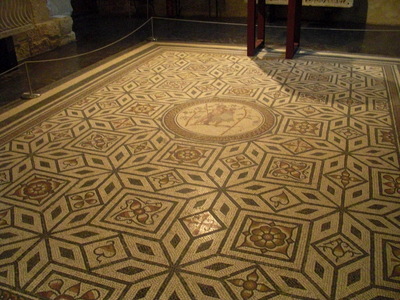
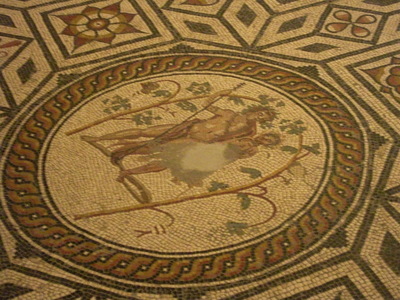 This mosaic was presumably the floor of a dining room. The guides pointed out that floors in, e.g., living rooms tended to have all-over designs, whereas those in Roman dining rooms had a design in the middle that would be visible during dinner, while the rest of the floor around the sides would be covered by dining couches.
This mosaic was presumably the floor of a dining room. The guides pointed out that floors in, e.g., living rooms tended to have all-over designs, whereas those in Roman dining rooms had a design in the middle that would be visible during dinner, while the rest of the floor around the sides would be covered by dining couches.
You weren't allowed to walk on it, so I could only get close enough to photograph the central medallion by leaning in from the side. Unfortunately, a big splotch in the center of the female figure was missing and had to be filled in with plain cement.
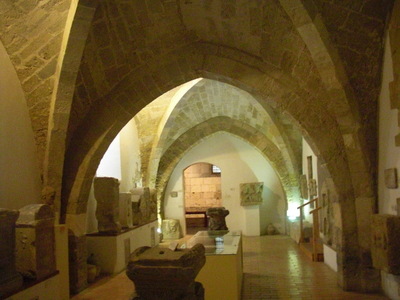
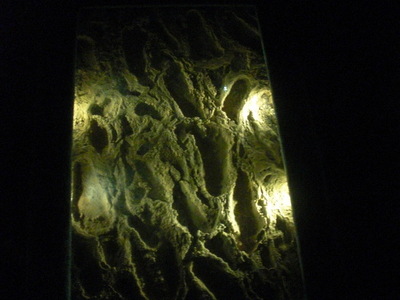 Because all this stuff was displayed in the old bishop's palace, the building itself was worth a look, for example for these lovely early gothic pointed arches on the ceiling.
Because all this stuff was displayed in the old bishop's palace, the building itself was worth a look, for example for these lovely early gothic pointed arches on the ceiling.
The prehistory room, strangely placed as a cul de sac off the middle of the route through the antiquity rooms, was great. David never saw it because he spent all his time trailing the guides from the mayor's office, but I spent a good deal of time there. I grouped tools according to occupation—hunting, tool-making, sewing and butchering. As usual, the displays included many needles, awls, knives, scrapers, spearheads, arrowheads, etc., as well as what they called "armatures de sagai" (atl-atl hooks). These were little pointed pieces made of something hard, like bone, shell, or stone, that were fixed to the ends of sticks that hunters used to increase the range of their spear throws. The thrower held one end of the stick, the armature at the other end engaged a socket in blunt end of the spear, and the stick functioned essentially as an extension of the length of the thrower's arm. You can buy modern plastic ones that engage a tennis ball rather than a spear to increase throwing range and reduce fatigue during games of fetch with your dog.
The displays emphasized that, in this region, Neanderthals and modern humans coexisted before the Neanderthals died out.
The coolest display, in my opinion, was the cast of prehistoric human footprints in the mud floor of a nearby rock shelter, interspersed with the footprints of a hyena. Researchers have spotted what they think are the distinct footprints of hundred of people, probably left over a period of many years. Because they were near the back of the cave, where the light was poor, few people ventured back that far, and the last layers were preserved.
The museum closed at noon for the lunch break, so we had to exit with the morning's last school group. Its terrific guide, Marion, addressed us outside the door, asking if we were the anglophone party her colleague had referred to her. We weren't, but she invited us anyway to rejoin the group at 1:30 p.m. at the Clos de la Lombarde, the site of the actual dig of the Maison des Portiques, about a 10-min walk away. It's still active and is not normally open to the public, but by special arrangement, the school group would reconvene there after lunch, along with this other anglophone party, for a tour. We agreed enthusiastically and went in search of lunch.
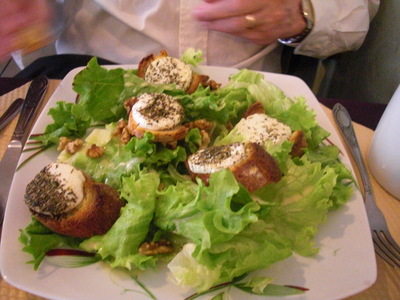
 Along the route to the dig, we encountered La Fringale (a common name for modest French eateries, meaning "hunger"), which sat only about 12 people—fortunately, we beat the rush.
Along the route to the dig, we encountered La Fringale (a common name for modest French eateries, meaning "hunger"), which sat only about 12 people—fortunately, we beat the rush.
David had his usual salad with walnuts and hot goat cheese on croutons, in this case, liberally sprinkled with herbes de Provence.
I had a ham and lardon omelet—pretty good; overcooked to my way of thinking, but the chef/owner/waiter seemed very proud of it. He explained at length how you had to make it on a really hot griddle and to cover it so that it would puff up during cooking.
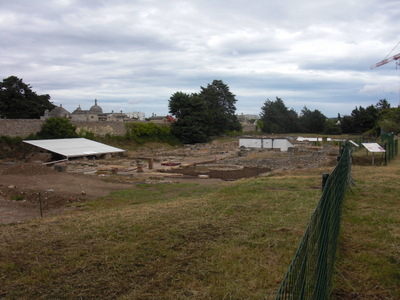
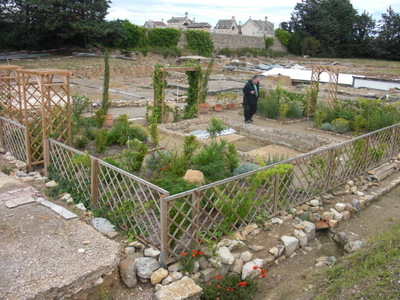 After polishing those off, we continued on the route described by the guide—off the edge of our little city map, straight through the middle of the tree-shaded traffic rotary, continue until you see a large hedge of trees, and the dig is right behind that. We set off down what seemed to be the right road, toward a distant group of sycamores that could be called a hedge of trees, but well before we reached it, on our right appeared an actual hedge of trees— tall junipers bare to a height of 12 feet or so and then trimmed to form a square elevated hedge. A large sign assured us that this was, in fact, the Clos de la Lombarde. A guy was just unlocking the gate, but otherwise, we were the first ones there. Shortly afterward, Marion the guide arrived more or less simultaneously with the other anglophone, a Brit who introduced himself to her, in pretty good French, as "Mr. Wilson" and explained that he had been there 40 years earlier, when excavations were just beginning on the site. We hoped to talk to him after the tour, but we never got the chance.
After polishing those off, we continued on the route described by the guide—off the edge of our little city map, straight through the middle of the tree-shaded traffic rotary, continue until you see a large hedge of trees, and the dig is right behind that. We set off down what seemed to be the right road, toward a distant group of sycamores that could be called a hedge of trees, but well before we reached it, on our right appeared an actual hedge of trees— tall junipers bare to a height of 12 feet or so and then trimmed to form a square elevated hedge. A large sign assured us that this was, in fact, the Clos de la Lombarde. A guy was just unlocking the gate, but otherwise, we were the first ones there. Shortly afterward, Marion the guide arrived more or less simultaneously with the other anglophone, a Brit who introduced himself to her, in pretty good French, as "Mr. Wilson" and explained that he had been there 40 years earlier, when excavations were just beginning on the site. We hoped to talk to him after the tour, but we never got the chance.
The, in quick succession, the rest of the archeologists (about three people, including the grand old man of the site, who initiated the work 40 years ago (and is the one who picked up all those plaster chips and reassembled them into the frescos in the museum), and an older lady who was in charge of martialling our group and who was pretty panicky at the prospect of 60 fidgeting and chattering middle-schoolers' being allowed inside the fences) and the school group (two combined classes, the nice quiet one that Marion had had in the museum and another, much rowdier crowd).
Marion explained that the site consisted of one entire city block of the Roman city, bounded by four streets—pretty small in comparison to the vast areas being excavated in Vienne and Vaison la Romaine, but completely unprecedented in this part of the world. It waS only preserved and available for study because it happened to be contiguous to the city's major cemetery (you can see its wall at the left-hand side, and beyond the wall, a cluster of family vaults and funerary chapels) and was therefore in government hands, being held for expansion of the cemetery. In the photo on the left, the near corner of the excavated area (beyond the grass and marked by darker soil) is the Maison des Portiques; the round stone structure is one of two pools in its atrium. The areas of white are temporary shelters with tin roofs set up to protect particular features. Beyond the Maison des Portiques is another house, apparently contemporary with it, this one of Greek design. It's front garden was reconstructed this year and is shown at the right, along with Mr. Wilson, who was allowed into places we and the school kids couldn't go. Beyond that house was a set of Roman baths; when we were allowed into the grassy area near the cemetery wall, outlined in the photos by red and white plastic chains, we could see into part of the hypocaust that heated the baths. As long as the kids were inside the main fences, they had to walk strictly two-by-two, follow exactly in the guide's footsteps, touch nothing, and above all, not pick up anything on the ground!
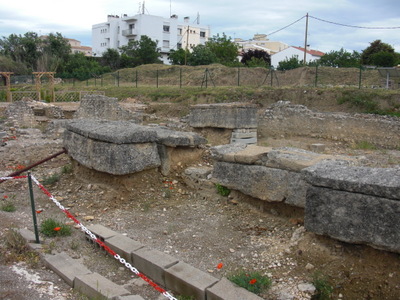
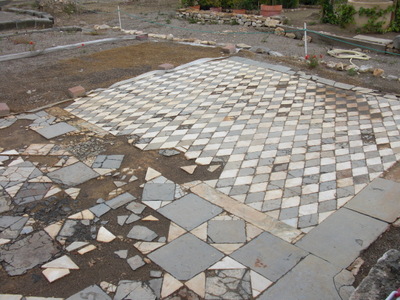 These two photos were taken from the area inside the red and white chains. Unfortunately, well after the time of the two houses, the first Christian basilica in Narbonne was built on this site, reusing some of the foundations of the houses and generally disrupting their floor plans. The stone objects in the left-hand photo are sarcophagi from the basilica.
These two photos were taken from the area inside the red and white chains. Unfortunately, well after the time of the two houses, the first Christian basilica in Narbonne was built on this site, reusing some of the foundations of the houses and generally disrupting their floor plans. The stone objects in the left-hand photo are sarcophagi from the basilica.
On the right is the floor from a portion of the Greek style house. It's thought to be the dining room, which is huge for the size of the house (known as the house of the huge dining room). The smaller tiles represent the serving area, where the servants prepared the food, and the larger tiles the area where the diners reclined in a large U-shaped area and were served. Speculation is that the owner of the house had reason to entertain large groups of people. The view from the dining room is across a hall and out into the garden. On the way to the site, we walked through the site of the Roman forum, now pretty well built over, so in their day these houses would have been closer to the center of town than they are to today's center.
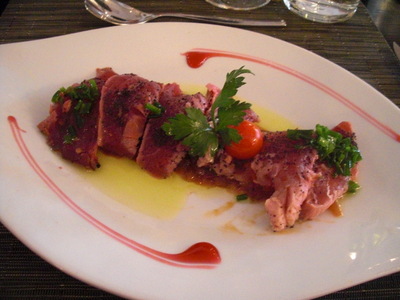
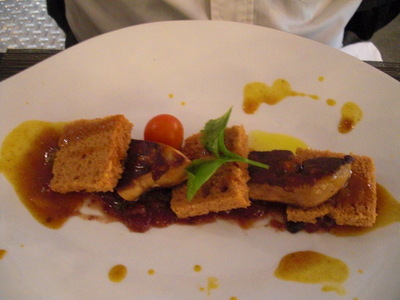 After cleaning up and resting our feet for a while back at the hotel, we went out for dinner at Brasserie CO, on the banks of the Canal de la Robine and across the street from the central market. I chose the menu at 23 euros and David the one at 31 euros—so far this trip restaurant prices have been remarkably reasonable. Even the place with all the smoke, mirrors, and liquid nitrogen, the menu we chose was under 50 euros.
After cleaning up and resting our feet for a while back at the hotel, we went out for dinner at Brasserie CO, on the banks of the Canal de la Robine and across the street from the central market. I chose the menu at 23 euros and David the one at 31 euros—so far this trip restaurant prices have been remarkably reasonable. Even the place with all the smoke, mirrors, and liquid nitrogen, the menu we chose was under 50 euros.
First course, David: Sautéed foie gras layered with slices of "pain d'épices," all on top of a sweet onion jam. Very good.
First course, me: Tataki of tuna, also quite good. The red comets were something very tart; cranberry syrup, maybe? Or pomegranate?
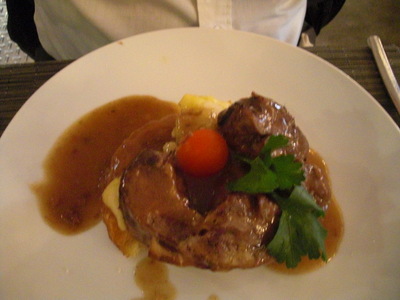
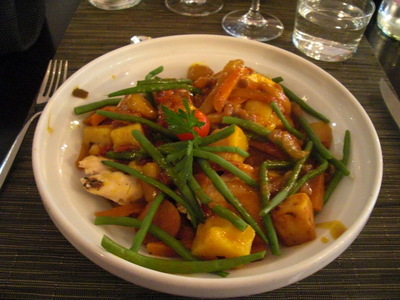 Main course, David: Seven-hour lamb, which was incredibly good! It was served on a purée of celery root and potatoes.
Main course, David: Seven-hour lamb, which was incredibly good! It was served on a purée of celery root and potatoes.
Main course, me: Chicken tagine with apricots. A chicken tagine made by a Brit who had seen a photo of one once; subtle to the point of blandness. It consisted of large chunks of boneless cooked chicken breast that had never seen a spice until they were combined with the rest of the dish for serving, potatoes and carrots (both sticks and pennies, cooked to different degrees) that had been cooked in a tomato-juice sort of sauce, and lovely crisp-tender green beans sprinkled over the top that had also never seen the sauce before and were completely at odds with the rest of the dish. A few tiny bits of what looked like red bell pepper lay in the bottom, and I think I found part of one dried apricot, but you couldn't be sure from the taste of either one—they tasted just like the tomato sauce. The chef might have waved the cumin bottle at the pot of simmering vegetables, but I don't think he added any. The chicken even had a few grill marks on it, but I think they were purely decorative—it was cooked before it ever saw the grill. A great disappointment. Most non-Middle-Eastern places that include a tagine on the menu do so because they have a north African working in the kitchen; if this place ever had one, he's long gone.
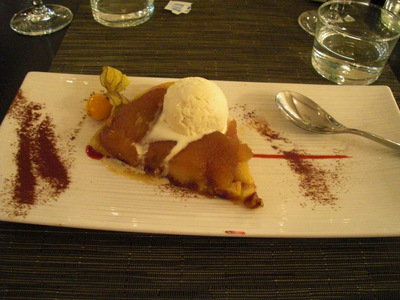
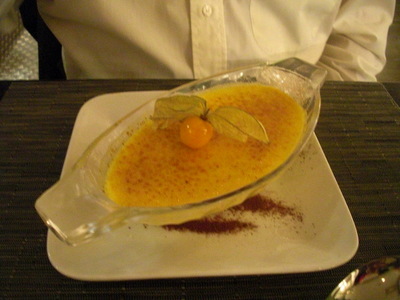 Dessert, David: Crème catalan. Basically, a very good crème brulée. When we were in Perpignan for the meiofauna meetings in 1993, we had crème catalan several times, and it was always flavored with dill. We were told that's what made it a crème catalan andnot just a crème brulée. Last year and this year, though, we've ordered it several times, never found a trace of dill, and when we asked about it, were looked at as though we were from the moon! We'll have to try it in Perpignan.
Dessert, David: Crème catalan. Basically, a very good crème brulée. When we were in Perpignan for the meiofauna meetings in 1993, we had crème catalan several times, and it was always flavored with dill. We were told that's what made it a crème catalan andnot just a crème brulée. Last year and this year, though, we've ordered it several times, never found a trace of dill, and when we asked about it, were looked at as though we were from the moon! We'll have to try it in Perpignan.
Dessert, me: Tarte tatin. An exemplary tarte tatin but somehow not very exciting. Very sweet. The bourbon vanilla ice cream was good, though. (That's a kind of vanilla; the ice cream did not have bourbon in it.)
previous entry
List of Entries
next entry

 I, on the other hand, checked in with the groups from time to time but mainly came and went, reading the explanatory materials and spending a good deal of time in the one large room (halfway through the tour) devoted to prehistory, which the school groups skipped, sticking to Greek and Roman antiquity.
I, on the other hand, checked in with the groups from time to time but mainly came and went, reading the explanatory materials and spending a good deal of time in the one large room (halfway through the tour) devoted to prehistory, which the school groups skipped, sticking to Greek and Roman antiquity.
 After the frescos come several rooms of three-dimensional artifacts, including the ubiquitous amphorae of all sizes (you can see some to the left of the giant anchor. Amphorae were the beer cans and plastic drink bottles of antiquity, but couldn't be recycled. They were used to ship and store everything from wine and olive oil to grain and coins and were so cheap to produce that returning them for reuse wasn't economically worthwhile, so they are everywhere. They were used to construct vapor barriers under newly constructed houses (see my 2011 blog), were broken up and used as filler in brick and stone walls or in beaten-earth pavements, and lay around in heaps, just as they do now in any empty corner of a museum.
After the frescos come several rooms of three-dimensional artifacts, including the ubiquitous amphorae of all sizes (you can see some to the left of the giant anchor. Amphorae were the beer cans and plastic drink bottles of antiquity, but couldn't be recycled. They were used to ship and store everything from wine and olive oil to grain and coins and were so cheap to produce that returning them for reuse wasn't economically worthwhile, so they are everywhere. They were used to construct vapor barriers under newly constructed houses (see my 2011 blog), were broken up and used as filler in brick and stone walls or in beaten-earth pavements, and lay around in heaps, just as they do now in any empty corner of a museum. 
 This mosaic was presumably the floor of a dining room. The guides pointed out that floors in, e.g., living rooms tended to have all-over designs, whereas those in Roman dining rooms had a design in the middle that would be visible during dinner, while the rest of the floor around the sides would be covered by dining couches.
This mosaic was presumably the floor of a dining room. The guides pointed out that floors in, e.g., living rooms tended to have all-over designs, whereas those in Roman dining rooms had a design in the middle that would be visible during dinner, while the rest of the floor around the sides would be covered by dining couches.
 Because all this stuff was displayed in the old bishop's palace, the building itself was worth a look, for example for these lovely early gothic pointed arches on the ceiling.
Because all this stuff was displayed in the old bishop's palace, the building itself was worth a look, for example for these lovely early gothic pointed arches on the ceiling.
 Along the route to the dig, we encountered La Fringale (a common name for modest French eateries, meaning "hunger"), which sat only about 12 people—fortunately, we beat the rush.
Along the route to the dig, we encountered La Fringale (a common name for modest French eateries, meaning "hunger"), which sat only about 12 people—fortunately, we beat the rush.
 After polishing those off, we continued on the route described by the guide—off the edge of our little city map, straight through the middle of the tree-shaded traffic rotary, continue until you see a large hedge of trees, and the dig is right behind that. We set off down what seemed to be the right road, toward a distant group of sycamores that could be called a hedge of trees, but well before we reached it, on our right appeared an actual hedge of trees— tall junipers bare to a height of 12 feet or so and then trimmed to form a square elevated hedge. A large sign assured us that this was, in fact, the Clos de la Lombarde. A guy was just unlocking the gate, but otherwise, we were the first ones there. Shortly afterward, Marion the guide arrived more or less simultaneously with the other anglophone, a Brit who introduced himself to her, in pretty good French, as "Mr. Wilson" and explained that he had been there 40 years earlier, when excavations were just beginning on the site. We hoped to talk to him after the tour, but we never got the chance.
After polishing those off, we continued on the route described by the guide—off the edge of our little city map, straight through the middle of the tree-shaded traffic rotary, continue until you see a large hedge of trees, and the dig is right behind that. We set off down what seemed to be the right road, toward a distant group of sycamores that could be called a hedge of trees, but well before we reached it, on our right appeared an actual hedge of trees— tall junipers bare to a height of 12 feet or so and then trimmed to form a square elevated hedge. A large sign assured us that this was, in fact, the Clos de la Lombarde. A guy was just unlocking the gate, but otherwise, we were the first ones there. Shortly afterward, Marion the guide arrived more or less simultaneously with the other anglophone, a Brit who introduced himself to her, in pretty good French, as "Mr. Wilson" and explained that he had been there 40 years earlier, when excavations were just beginning on the site. We hoped to talk to him after the tour, but we never got the chance.
 These two photos were taken from the area inside the red and white chains. Unfortunately, well after the time of the two houses, the first Christian basilica in Narbonne was built on this site, reusing some of the foundations of the houses and generally disrupting their floor plans. The stone objects in the left-hand photo are sarcophagi from the basilica.
These two photos were taken from the area inside the red and white chains. Unfortunately, well after the time of the two houses, the first Christian basilica in Narbonne was built on this site, reusing some of the foundations of the houses and generally disrupting their floor plans. The stone objects in the left-hand photo are sarcophagi from the basilica. 
 After cleaning up and resting our feet for a while back at the hotel, we went out for dinner at Brasserie CO, on the banks of the Canal de la Robine and across the street from the central market. I chose the menu at 23 euros and David the one at 31 euros—so far this trip restaurant prices have been remarkably reasonable. Even the place with all the smoke, mirrors, and liquid nitrogen, the menu we chose was under 50 euros.
After cleaning up and resting our feet for a while back at the hotel, we went out for dinner at Brasserie CO, on the banks of the Canal de la Robine and across the street from the central market. I chose the menu at 23 euros and David the one at 31 euros—so far this trip restaurant prices have been remarkably reasonable. Even the place with all the smoke, mirrors, and liquid nitrogen, the menu we chose was under 50 euros.
 Main course, David: Seven-hour lamb, which was incredibly good! It was served on a purée of celery root and potatoes.
Main course, David: Seven-hour lamb, which was incredibly good! It was served on a purée of celery root and potatoes.
 Dessert, David: Crème catalan. Basically, a very good crème brulée. When we were in Perpignan for the meiofauna meetings in 1993, we had crème catalan several times, and it was always flavored with dill. We were told that's what made it a crème catalan andnot just a crème brulée. Last year and this year, though, we've ordered it several times, never found a trace of dill, and when we asked about it, were looked at as though we were from the moon! We'll have to try it in Perpignan.
Dessert, David: Crème catalan. Basically, a very good crème brulée. When we were in Perpignan for the meiofauna meetings in 1993, we had crème catalan several times, and it was always flavored with dill. We were told that's what made it a crème catalan andnot just a crème brulée. Last year and this year, though, we've ordered it several times, never found a trace of dill, and when we asked about it, were looked at as though we were from the moon! We'll have to try it in Perpignan.